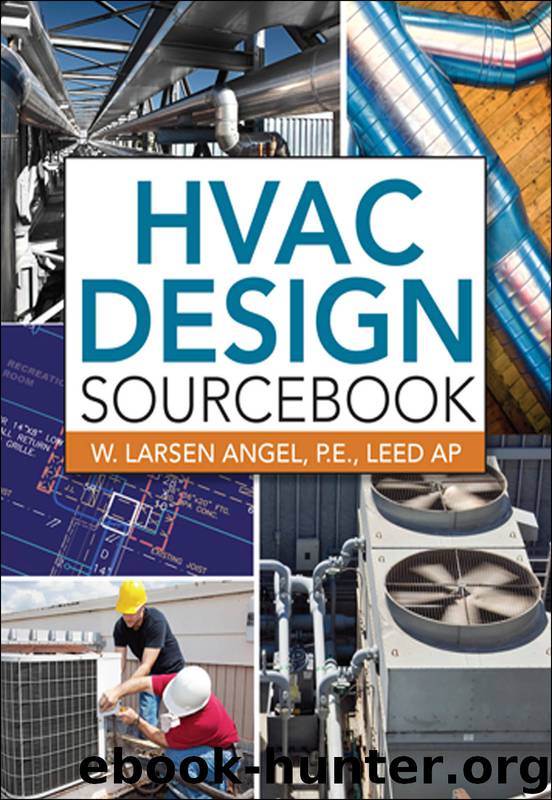HVAC Design Sourcebook by W. Larsen Angel

Author:W. Larsen Angel
Language: eng
Format: epub
Publisher: McGraw-Hill
Published: 2012-06-28T16:00:00+00:00
Endnotes
1. HVAC air systems may also provide humidification and dehumidification for the spaces they serve.
2. HVAC air systems that serve laboratories or other spaces with high exhaust airflows may have a significantly higher percentage of outdoor air.
3. In an indirect gas-fired heater, fuel is burned within a combustion chamber that is separate from the conditioned airstream, and the products of combustion are vented to the outdoors. In a direct gas-fired heater, the fuel is burned directly within the conditioned airstream; thus the products of combustion are entrained within the conditioned air and are delivered to the spaces served.
4. Depending upon the project, these spaces may require cooling as well as heating and ventilation.
5. The primary air duct is the portion of the supply air duct system between the VAV air handling unit and the VAV terminal units.
6. VAV terminal units without a fan are called single-duct VAV terminal units. Those that contain a fan are called fan-powered VAV terminal units.
7. Other methods of modulating fan airflow are available, such as the use of inlet guide vanes or discharge dampers. However, these methods are less energy efficient than the use of VFDs. Furthermore, recent improvements in VFD technology and reduced cost have made VFDs the first choice for modulating fan airflow for VAV systems.
8. DX refrigerant cooling coils are not as “forgiving” as chilled water coils. Without adequate unloading capabilities in the refrigeration system, the saturated suction pressure of the refrigerant will drop at low-load conditions, which could cause a decrease in the cooling coil temperature below the freezing point of water. If this occurs, any moisture on the cooling coil will freeze, leading to further freezing of the moisture contained within the air flowing through the coil. This could eventually lead to a complete freeze-up of the coil and blockage of airflow through the coil.
9. The purpose of the minimum position for the primary air damper in a VAV terminal unit is to provide minimum ventilation airflow to the zone. A minimum primary air damper position is necessary only for zones that have a heating load. For zones with a heating load, there could be times when the (external) heat losses from the zone equal the (internal) heat gains to the zone, producing a net zone cooling load of zero. With no zone cooling load, the primary air damper in the VAV terminal unit would close completely (even though the zone could be occupied and require ventilation) were it not for the minimum primary air damper position. A heating coil in the VAV terminal unit is required in this case to prevent the possibility of overcooling the zone when the primary air damper is at its minimum position.
10. The primary air damper in VAV terminal units serving zones that do not have any heating load (purely interior spaces) can have a minimum position that is fully closed because if there is no zone cooling load, the zone would have to be unoccupied. That is, there would be no internal heat gains from lights, equipment, or people.
Download
This site does not store any files on its server. We only index and link to content provided by other sites. Please contact the content providers to delete copyright contents if any and email us, we'll remove relevant links or contents immediately.
Audition by Ryu Murakami(4098)
The Body: A Guide for Occupants by Bill Bryson(3800)
Adulting by Kelly Williams Brown(3669)
Housekeeping by Marilynne Robinson(3401)
Zero Waste Home by Bea Johnson(3288)
Be in a Treehouse by Pete Nelson(3211)
Seriously... I'm Kidding by Ellen DeGeneres(3100)
Better Homes and Gardens New Cookbook by Better Homes & Gardens(2953)
Barkskins by Annie Proulx(2879)
The Healing Self by Deepak Chopra(2795)
Hedgerow by John Wright(2776)
The Life-Changing Magic Of Tidying Up- The Japanese Art Of Decluttering And Organizing (v5.0) by Marie Kondo(2744)
Spark Joy by Marie Kondo(2674)
The Genius of Japanese Carpentry by Azby Brown(2608)
The Cellar by Natasha Preston(2594)
Work Clean by Dan Charnas(2562)
120 Days of Sodom by Marquis de Sade(2435)
The Book of Numbers by Peter Bentley(2404)
A Monk's Guide to a Clean House and Mind by Shoukei Matsumoto(2404)
